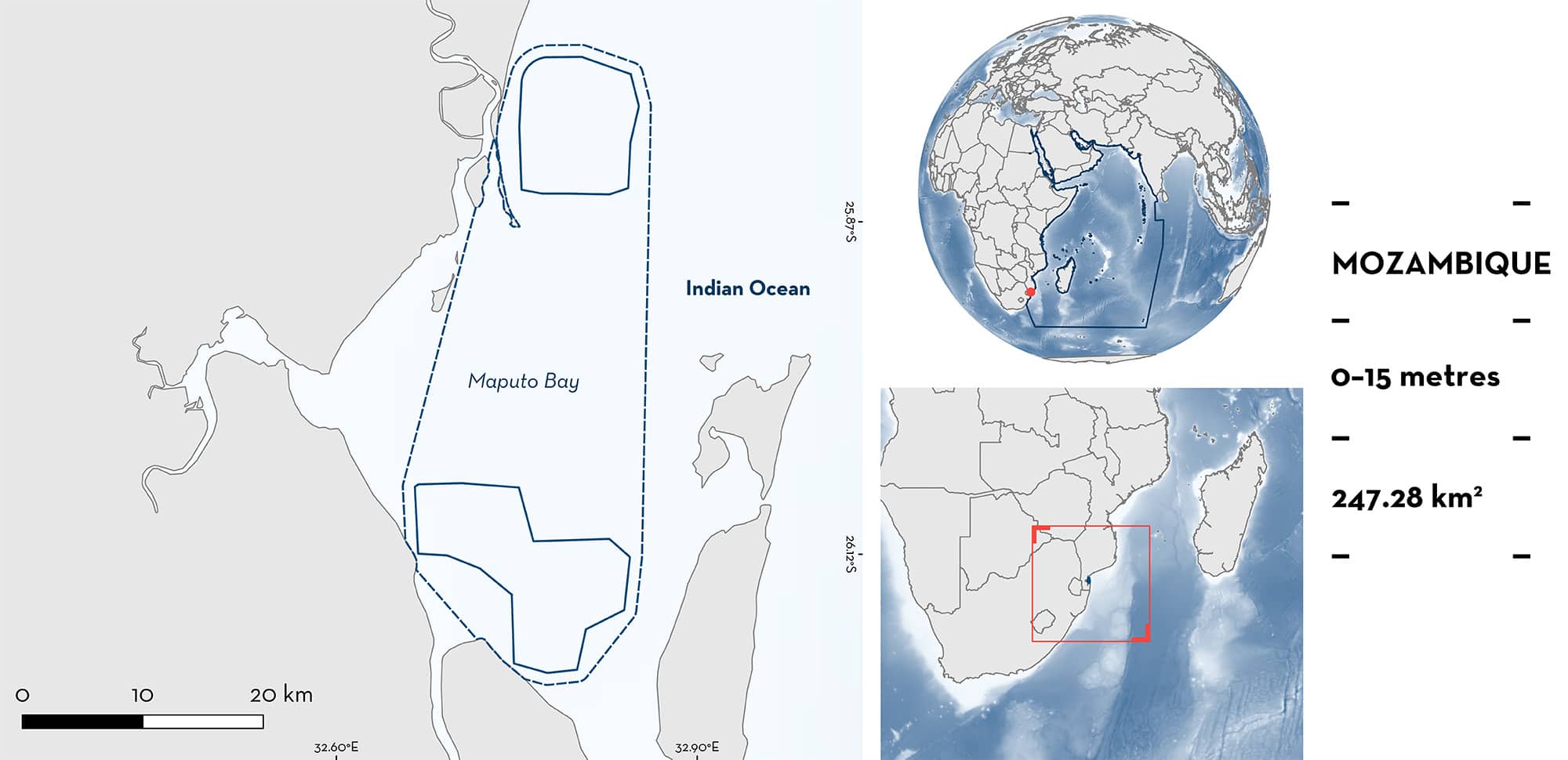ISRA FACTSHEETS
ISRA FACTSHEETS
WESTERN INDIAN OCEAN REGION
Maputo Bay
Summary
Maputo Bay forms part of a large bay in southern Mozambique. This area receives freshwater input primarily from five rivers: Incomati in the north, Maputo in the south, Umbeluzi, Matola, and Tembe in the west. At the entrance of the bay, there are dynamic sand banks, while mangroves and seagrass beds characterise much of the coastal habitat within it. Maputo Bay is shallow and predominantly sandy, with muddy areas at the entrance to river mouths. The area overlaps with the Incomati River to Ponta do Ouro and the Mozambique Channel Ecologically or Biologically Significant Marine Areas. Within this area there are: threatened species and reproductive areas (Milk Shark Rhizoprionodon acutus).
Download factsheet
Maputo Bay
DESCRIPTION OF HABITAT
Maputo Bay is part of a large bay located in southern Mozambique. Mangrove habitats occupy 14% of the larger bay, while seagrass meadows occupy 3% (Bento et al. 2023). The area receives freshwater input from several rivers (Incomati, Maputo, Umbeluzi, Matola, and Tembe), but is considered a saline environment, with the vertical profiles of salinity and temperature in the bay being considered vertically homogeneous (Canhanga & Dias 2005). River discharge has a strong seasonal cycle, with higher outflow during November–April (Markull et al. 2014). The area lies directly in front of the Incomati and Maputo River mouths and has a high tidal range of up to ~3 m (Markull et al. 2014). The area is split into a northwestern site off Macaneta Beach and a southern site off the mouth of the Maputo River. It is a shallow area with a depth of 5–15 m and the waters of the area in general being mostly ~10 m deep reaching 30 m at the mouth of the bay (Canhanga & Dias 2005). The area is characterised by sandy and muddy substrates.
Maputo Bay overlaps with the Incomati River to Ponta do Ouro and the Mozambique Channel Ecologically or Biologically Significant Marine Areas (EBSA; CBD 2023a, 2023b), and is also situated adjacent to the identified priority Ramsar site of the Maputo National Park, which is also a Key Biodiversity Area (KBA 2023).
This Important Shark and Ray Area is benthopelagic and extends from inshore and surface waters (0 m) to 15 m based on the bathymetry of the area.
CRITERION A
VULNERABILITY
The one Qualifying Species within the area is considered threatened with extinction according to the IUCN Red List of Threatened SpeciesTM. The Milk Shark is assessed as Vulnerable (Rigby et al. 2020).
CRITERION C
SUB-CRITERION C1 – REPRODUCTIVE AREAS
Maputo Bay is an important reproductive area for one shark species.
Artisanal fishery landing site surveys recorded Milk Shark neonates and young-of-the-year (YOY) between December 2018 and February 2020 at the Bairro dos Pescadores and Macaneta landing sites (Wildlife Conservation Society & InOM unpubl. data 2023). Of the 57 individuals landed, 44 were measured and had a total length (TL) ranging from 29–97 cm TL, with a mean of 42.8 ± 11.4 cm TL. Most of the individuals were in the 25–49.9 cm TL size class, with 32 neonates and 11 YOY. Size-at-birth for this species is ~25–45 cm TL (Harry et al. 2010; Shaaban et al. 2018) and, considering the growth rate for this species (K = 0.18 year-1; Ba et al. 2015), YOY individuals are ~43–63 cm TL. All Milk Sharks were caught in the austral summer from December to April, indicating a seasonal peak in pupping during the wet season characterised by high river discharge. Although no size data are available from other years, fishers indicated that they continued catching the species (Wildlife Conservation Society & InOM unpubl. data 2023).
Between 14 August and 8 September 2023, 30 fishers were interviewed to determine where they catch Milk Sharks in Maputo Bay. Fishers operate throughout the region, except inside the shipping channel that connects Maputo harbour to the open sea. Of these, nine indicated that they had caught Milk Sharks in the past and knew the locations where they normally catch them. A map with grid cell references was then shown to each of these nine fishers who pointed out which grid cells were the main areas where they catch Milk Sharks.
Of note is that artisanal fishery landing site surveys took place at several other locations along the Mozambique coastline in the provinces of Inhambane, Zambezia, Nampula, and Cabo Delgado, yet the only sites where neonate and YOY Milk Sharks were landed were within the area at Macaneta and Bairro dos Pescadores (Wildlife Conservation Society & InOM unpubl. data 2023), thus indicating that Maputo Bay is an important reproductive area for this species in Mozambique.
Download factsheet
SUBMIT A REQUEST
ISRA SPATIAL LAYER REQUEST
To make a request to download the ISRA Layer in either a GIS compatible Shapefile (.shp) or Google Earth compatible Keyhole Markup Language Zipped file (.kmz) please complete the following form. We will review your request and send the download details to you. We will endeavor to send you the requested files as soon as we can. However, please note that this is not an automated process, and before requests are responded to, they undergo internal review and authorization. As such, requests normally take 5–10 working days to process.
Should you have questions about the data or process, please do not hesitate to contact us.


